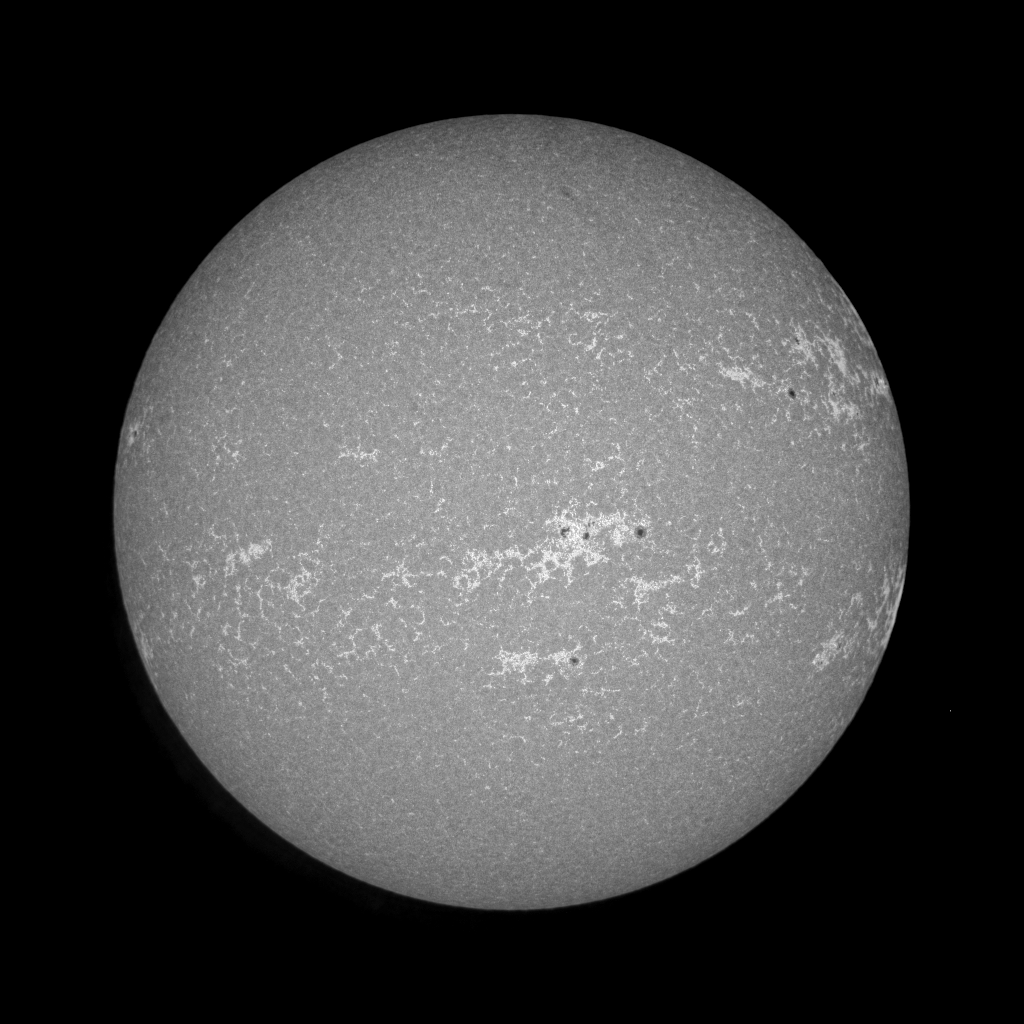Caldwell 13 Owl Cluster and M82 Cigar Galaxy.
Both of these images were taken from my back garden in Castleford on the 28th October 2014. They are both made up of around 45 60 second exposures (ISO 1600) stacked in Deep Sky Stacker with 30 darks and 30 bias frames. Then processed in photoshop. I used a Canon 1200d SLR mounted on a Skywatcher 200PDS with a HEQ5Pro.
The Sun in Hydrogen-Alpha
Taken using the WYAS Tele-Vue Pronto with Coronado Solar Filters. A
4-Panel mosaic with each panel captured with a QHY5L-II Colour planetary
camera running at 30fps @ 1280x960 resolution. Captured in raw SER
mode, converted to AVI using PIPP, stacked and wavelet processed in
Registax, then assembled in Photoshop.
06/08/2014
06/08/2014
Mars at Opposition
15/4/2014
JUPITER and its MOONS
A widefield image of Jupiter and its moons (L to R: Callisto, Io, JUPITER, Europa and Ganymede) taken from the observatory pad. Stacked and processed in Registax6, then colour balanced in PixInsight.
A closeup view of Jupiter and Io.
Both images taken with a Celestron 5se scope and a QHY5L-II camera. A Celestron 2x Barlow was used for the closeup image.
8/4/2014
A closeup view of Jupiter and Io.
Both images taken with a Celestron 5se scope and a QHY5L-II camera. A Celestron 2x Barlow was used for the closeup image.
8/4/2014
WYAS Moon Astrophotography Challenge 15th April 2014
This Full moon image was taken with a DSLR using an 8” SCT telescope. The image is a composite of 2
moon halves, each half being a high definition image made up of a stack of 30 DSLR
images taken with 1/60th second exposure at ISO 640 with a Canon
40D. The two halves were then merged in
Photoshop.
Moon 13th March 2014
This image of the Moon taken on Wednesday 13th March 2014 is a mosaic composite
image. Taken using a Celestron 8" SCT and a DMK
21AU04 CCD Mono Image camera.
This composite image consists of 74 video .avi files, each of 1000 frames approx. 16 seconds in length. Each video file is processed using RegiStax to create a single .tif image. These single tif images are then assembled in Adobe Photoshop to create the final overall Moon image.
This composite image consists of 74 video .avi files, each of 1000 frames approx. 16 seconds in length. Each video file is processed using RegiStax to create a single .tif image. These single tif images are then assembled in Adobe Photoshop to create the final overall Moon image.
National Astronomy Week Event 4th March 2014
WYAS held a special opening at the Rosse observatory on March 4th as part of National Astronomy Week.
The theme was “Jupiter and its moons” The event was well attended by the public and club members. We had our 14” SCT in the dome operational, plus our 18”, 10”, 8” scopes and reverse binoculars all in use by the public.
We setup astrophotography on the 8” SCT and took these images during the night of Jupiter with a Phillips SPC800 web cam and Orion using a DSLR with a 40sec exposure at ISO3200.
This is my attempt at imaging the supernova in M82 on the 23rd January 2014. The image was taken through a Televue 102 on a Celestron CGEM mount guided via a Lodestar guider through a separate refractor. 1.25-inch Baader filters were used in an Atik filter wheel. The main camera was an Atik 314L+ controlled through MaximDL. Some images lost to satellites and planes, so 20 mins green, 15 mins blue, 35 mins Luminance and 50 mins hydrogen alpha 35nm. Calibrated and stacked in MaximDL. Final processing done in Photoshop CS6.
This is my first attempt at the Horsehead Nebula in Orion on the 19/1/2014. 15 x 5 minute exposures in Luminance only filter. Telescope was 102mm Televue refractor using an Atik 314L camera cooled to -20C. Guided by a Lodestar guider. Seeing very steady with a hint of mist forming - very icy on the ground.
Messier 33 - Triangulum Galaxy
The Triangulum Galaxy is a spiral galaxy approximately 3 million light years from Earth in the constellation Triangulum. The Triangulum Galaxy is the third-largest member of our Local Group of galaxies, which includes the Milky Way, the Andromeda Galaxy and about 44 other smaller galaxies. It is one of the most distant permanent objects that can be viewed with the naked eye.
25/11/2013
36x300sec Subs, Darks, Flats and Bias
NGC7023 - The Iris Nebula
The Iris Nebula (also known as Caldwell 4) is a bright reflection nebula in the constellation Cepheus. NGC 7023 is actually the cluster within the nebula, with the nebula lit by a magnitude +7 star (SAO 19158) within the cluster. The nubula lies 1,300 light-years away and is approximately six light-years across.
27/11/2013
82x300sec Subs, Darks, Flats and Bias
27/11/2013
82x300sec Subs, Darks, Flats and Bias
Subscribe to:
Posts (Atom)
.jpg)
%2BJPEG.jpg)
.jpg)












